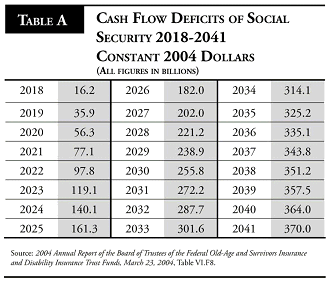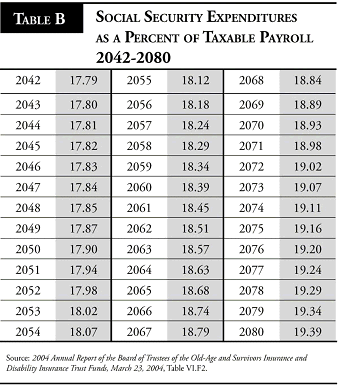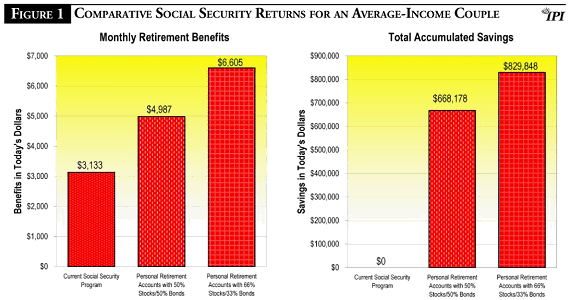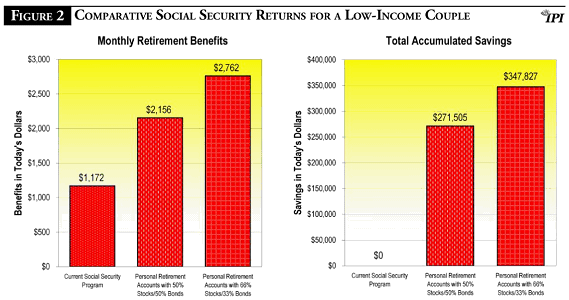A common response to President Bush’s call for Social Security reform is to argue preposterously that there is nothing wrong (or not much wrong) with the current Social Security system, and so reform is not necessary. While there are many good reasons for fundamental Social Security reform involving personal accounts, there are two basic, overriding problems that compel reform now.
The first is that the current Social Security system is going bankrupt and will impose huge burdens on taxpayers and retirees. Second is that the current system has become a bad deal for working people. Workers would be receiving much higher returns and benefits today had they been allowed to choose a personal account option. Every day that goes by, workers lose more and more that they cannot make up.
Social Security’s Financing Problem
The financial problems of Social Security are fully documented in the annual reports of the Social Security Board of Trustees, which are produced by the Office of the Actuary at the Social Security Administration. The latest report shows that Social Security will begin to run a cash flow deficit in 2018. That is when the financing crisis begins.
Starting then, Social Security will have to begin cashing in its trust fund bonds to the federal government to get the money to pay all promised benefits. But the federal government has no cash or other assets dedicated to funding these bonds. To get the money, the government will then have to either raise taxes or increase federal borrowing and debt.
By 2024, this Social Security deficit will equal $140.1 billion in today’s dollars. By 2027, it will be $202.0 billion. By 2033, it will be $301.6 billion. From 2018 until the trust funds run out in 2042, taxpayers will have to come up with an extra $5.6 trillion to provide the cash to make good on the trust fund bonds and pay all promised Social Security benefits. See Table A.
After the trust fund bonds run out in 2042, the government would have to raise payroll taxes sharply in order to get the funds to continue paying all promised benefits. As Table B shows, the current payroll tax rate of 12.4 percent would have to be raised about 50 percent, to around 18 or 19 percent, to continue financing full benefits.1
The root of this long-term financial crisis is Social Security’s pay-as-you-go method of operation. Current taxes are not saved and invested to pay the future benefits of today’s workers. Rather, they are immediately paid out to finance the benefits of today’s retirees. The future retirement benefits of today’s workers are then to be paid by the taxes of future workers.
If Social Security were a fully funded savings and investment system, then enough reserve assets would be on hand to pay all the future benefits that had been earned at any point. By contrast, in a pay-as-you-go system like Social Security, adverse demographic or economic developments can upset the delicate balance between incoming revenues and outgoing benefits, and leave the system unable to meet its benefit promises.
Such adverse developments have been building in Social Security for decades. The most well known is the baby boom generation, whose retirement starting in less than 10 years will cause benefit expenditures to soar. Less well known is that the baby boom generation had historically low birth rates and a relatively small number of children. This “baby bust” means that just as the baby boom generation’s retirement will be causing benefit expenditures to soar, there will be a relatively small number of workers behind them to finance those benefits. Adding to the problem is increased life expectancy, which due to medical breakthroughs may leap ahead in the next century, far more than the Social Security Administration even dares to project.
These are reasons why the number of workers paying taxes into Social Security’s pay-as-you-go system has declined so precipitously relative to the number of retirees drawing benefits. The number of workers per retiree has declined from 42 in 1945 to just 3.3 today.2 This ratio is projected to decline by another 40 percent to 2.0 by 2040.3 For a pay-as-you-go system like Social Security, that spells financial disaster.
The Bad Deal Problem
But this long-term financing crisis is only one aspect of the problem. Another is that Social Security is no longer a good deal for working people. Even if Social Security could pay all of its promised benefits, those benefits would represent a low, below-market rate of return on the huge amount that workers and employers pay into the system. Workers would get much higher returns and benefits if they could save and invest their payroll taxes in their own accounts.
The average benefit today for a single retiree is only $920 per year. This reflects the pitiful returns Social Security offers. For most workers, even if Social Security could somehow pay all of its promised benefits, the real annual rate of return under the current program would still be 1 to 1.5 percent or less. For many it would be zero or even negative.4
Of course, as currently designed, Social Security will not be able to pay all of its promised benefits. Under the current system, either payroll taxes will have to be increased by more than 50 percent, or benefits will have to be cut by 40 percent or more, or some combination of the two. This would make the return from the Social Security system even worse than it is now. Most workers would then expect a zero or even negative real rate of return.
By contrast, the long-term real rate of return on corporate stocks is at least 7.0 to 7.5 percent annually.5 Indeed, since 1926 when the most reliable data starts, the real rate of return on large-company stocks listed on the New York Stock Exchange has been 7.2 percent.6 The real return on smaller-company stocks on the Exchange has been even higher, at 9.2 percent.7 This period covers the Great Depression, World War II, intermediate-sized wars, the turbulent inflation/recession years of the 1970s, and the recent high-tech bubble collapse. Moreover, these returns are conservatively based on the geometric mean of long-term stock returns. The calculation of long-term accumulations in personal accounts should really be made using the long-term arithmetic mean, which is significantly higher. On corporate bonds, meanwhile, the long-term real return has been around 3.5 percent.8
This large difference in returns adds up to an enormous difference in accumulated assets and benefits over a lifetime of work, investment, and retirement. We can see how much by looking at the legislation introduced by Rep. Paul Ryan (R-WI) and Sen. John Sununu (R-NH).
Their bill would allow workers, on average, to invest in personal accounts just over half of the total Social Security payroll tax of 12.4 percent, or roughly the employee share of the total tax. Specifically, the bill would allow workers to invest 10 percentage points of the 12.4 percent tax on the first $10,000 of wage income each year, and 5 percentage points of the tax on all taxable income above $10,000. This makes the account option progressive, with low-income workers investing a higher percentage of the tax than high-income workers. On average, workers would be able to contribute to the accounts 6.4 percentage points of the 12.4 percent payroll tax.
Let’s examine how this would work for an average-income, two-earner couple. The husband, age 40, earns an average income of $40,000 this year, and the wife, also age 40, earns an income of $30,000, which is consistent with U.S. Census Bureau data regarding the average income of two-earner married couples. Suppose they each entered the work force at age 23, with the husband earning $20,202 that year and the wife earning $15,152. They also each earn only the average salary increase each year. Suppose as well that they were able to exercise the personal account option described above from the start of their careers.
With a diversified portfolio invested half in bonds and half in stocks, and earning the standard, long-term market investment returns discussed above9, the couple would reach retirement with a total fund of $668,178, again in today’s dollars after adjusting for inflation. That fund would be able to pay them about 60 percent more than what Social Security promises, but cannot pay; $4,987 per month compared to $3,133. Remember, this results from the contributions to the accounts of only 10 percent of the first $10,000 in wages and 5 percent of everything above that, compared with about 10 percentage points of the Social Security tax going to Social Security retirement benefits.
Now suppose the couple invested two-thirds of their contributions in stocks and one-third in bonds over their working lives. This is actually the default option under the Ryan-Sununu bill, based on suggestions from the Chief Actuary of Social Security. With the above standard long-term market investment returns, the couple would reach retirement with $829,848 in today’s dollars. This would be enough to pay them over twice what Social Security promises but cannot pay, $6,605 per month versus $3,133.
Now take the example of a career low-income worker age 40 who earns only $20,000 this year. We assume that this worker did not go to college, entering the work force instead at age 19 and earning only $8,600 that year. He also earns only average wage increases each year, which leaves him in the same position relative to other workers each year as a worker earning $20,000 this year. Assume again that he is able to exercise our proposed personal account option from the start of his career.
With a portfolio of half bonds and half stocks earning standard returns, the worker would reach retirement with a trust fund of $271,505 in today’s dollars. That fund would pay the worker 84 percent more than Social Security promises but cannot pay, $2,156 per month compared to $1,172. With a portfolio of two-thirds in stocks and one-third in bonds earning standard returns, the worker would reach retirement with a personal account fund of $347,827 in today’s dollars. That fund would be enough to pay him well over twice what Social Security promises but cannot pay, $2,762 per month compared to $1,172.
Why this enormous gulf between what personal accounts can pay and what Social Security currently promises? The personal accounts operate as a fully funded system. The money paid in is saved and invested in new capital investments. These capital investments increase production, and the value of this production increase is returned to investors in the form of a rate-of-return or interest payment on their investments. Over the course of a lifetime, this return would accumulate to large sums, which would then be used to finance benefits in retirement.
But Social Security again operates on a pay-as-you-go basis, where the money paid in today is not saved and invested but is immediately paid out to finance current benefits. Under the current system, the future benefits of today’s workers are not to be paid by their savings and investments, but by future taxes to be paid by future workers. Such a system adds nothing to production. It is a mere redistribution system, transferring funds from one segment of the population to another. This means that workers under such a system lose the full amount of the increased production and associated returns they would get if their money were invested in private, productive assets through a fully funded system. The payroll tax-financed redistribution system can pay some effective return as revenues grow over time due to increased wages and population growth, enabling the system to pay more to retirees than just what they paid in. But this effective return, which is still obtained by a tax redistribution from others rather than increased production, will never be anywhere near as great as the full returns produced by capital investment.10
This analysis also shows why cutting future promised Social Security benefits through such proposals as price indexing is a bad idea. Price indexing would freeze benefits at today’s levels in real terms forever. With payroll taxes continuing to grow with wages, the miserable rates of return paid by Social Security would get worse every year, eventually pushing everyone well into the negative range.
The problem with Social Security is not that benefits are too high, but that they are far too low. As stated above, the average monthly Social Security benefit for single retirees today is only $920. We need personal accounts so workers will be able to get much higher benefits in the future.
Conclusion
Social Security suffers from two major problems that demand fundamental reform. First is that under the government’s own official projections, Social Security will not have nearly enough funds to pay all promised benefits to today’s middle-aged and younger workers. The program will require a massive infusion of additional funds from taxpayers starting in 2018 in order to keep paying all promised benefits. Moreover, it will require massive, unsustainable payroll tax increases after 2042 in order to pay all promised benefits after that time.
Additionally, even if the program could pay all of its promised benefits, those benefits would still represent a low, below-market return on the huge taxes workers and their employers are paying into the system. Workers would get much higher returns and benefits if they could save and invest their payroll tax funds in their own personal accounts. Workers would also own these funds directly and individually, and would be able to leave some or all of them to their families. If taxes are raised or benefits cut to deal with the long-term bankruptcy problem, then this bad-deal problem would get even worse.
It is easy to see how personal accounts would solve the second problem. Through the accounts, workers would be able to earn the much higher returns and benefits available through private capital markets. And a large enough personal account would solve the long-term bankruptcy problem as well. Under the accounts in the Ryan-Sununu bill, for example, which are equal in size roughly to the employee share of the tax, so much of the future benefit obligations of Social Security are shifted to the accounts that the program is left in long-term, permanent surplus. This is shown by the official score of the bill by the Chief Actuary of Social Security. Indeed, that score shows that over time, almost all of the retirement benefit obligations of the program are shifted to the accounts. But with 6 percentage points of the payroll tax still going into the old Social Security program, it is easy to see why the bill would result in a permanent surplus in the program.11
These problems of the current Social Security system are enormous, but surmountable. The right solution will not only solve Social Security’s problems, but also create an unprecedented opportunity for the personal prosperity of American workers.
Endnotes
- Table B shows Social Security expenditures as a percent of taxable payroll. A payroll tax rate set to those percentages would generate the revenue to meet those expenditures. Besides the payroll tax, Social Security obtains funds through the income taxation of Social Security benefits. Under current law, the revenues from that taxation are cycled back into Social Security. That revenue will be equivalent after 2042 to less than 1 percent of taxable payroll each year. But Social Security also needs some trust fund amounts to serve as a cash flow reserve where the money waits for a short while until the checks can be written. It also needs a reserve to back up the system during short-term recessions. The Social Security Administration consequently seeks as a standard for solvency a trust fund reserve equal at least to 100 percent of one year’s expenditures. If payroll tax rates are set to equal the amounts in Table B, then the income from the taxation of Social Security benefits can be used to build and maintain this reserve.
- The 2004 Annual Report of the Board of Trustees of the Federal Old Age and Survivors Insurance and Disability Insurance Trust Funds, Table IV.B2.
- Ibid.
- Peter Ferrara and Michael Tanner, A New Deal for Social Security, Washington, DC: Cato Institute, 1998, Chapter 4. See also William W. Beach and Gareth G. Davis, Social Security’s Rate of Return, A Report of the Heritage Center for Data Analysis, Washington, DC, No. CDA98-01, January 15, 1998.
- Ferrara and Tanner, pp. 72-73.
- Stocks, Bonds, Bills and Inflation, 2003 Yearbook, Chicago, IL: Ibbotson Associates Inc., 2003.
- Ibid.
- Ferrara and Tanner, p. 73. The Chief Actuary of Social Security also uses an assumed real return of 3.5 percent.
- This assumes, quite conservatively, a 7 percent real return on corporate stocks and a 3.5 percent real return on corporate bonds. We also assumed administrative costs of 25 basis points. The Chief Actuary of Social Security assumes the same for personal account plans, based on the most realistic studies. See “Testimony of William G. Shipman Before The House Budget Committee Task Force On Social Security”, April 27, 1999. That testimony, reflecting the most thorough and sophisticated work regarding the administration of personal accounts, actually shows that over the long run administrative costs for a well-designed personal account system would be less than half as much.
- For further discussion, see Peter J. Ferrara, Social Security Rates of Return for Today’s Young Workers, Washington, DC: National Chamber Foundation, 1986, pp. 8-11; Peter J. Ferrara and Michael Tanner, A New Deal for Social Security (Washington DC: Cato Institute, 1998), Chapt. 4.
- For further discussion, see Peter Ferrara, Personal Social Security Accounts That Work, Institute for Policy Innovation, Policy Report 185, November 2004.
About the Author
Peter Ferrara is a senior research fellow with the Institute for Policy Innovation and director of the Social Security Project for the Free Enterprise Fund.
About the Institute for Policy Innovation
The Institute for Policy Innovation (IPI) is a nonprofit, non-partisan educational organization founded in 1987. IPI’s purposes are to conduct research, aid development, and widely promote innovative and nonpartisan solutions to today’s public policy problems. IPI is a public foundation, and is supported wholly by contributions from individuals, businesses, and other non-profit foundations. IPI neither solicits nor accepts contributions from any government agency.
IPI’s focus is on developing new approaches to governing that harness the strengths of individual choice, limited government, and free markets. IPI emphasizes getting its studies into the hands of the press and policy makers so that the ideas they contain can be applied to the challenges facing us today.
